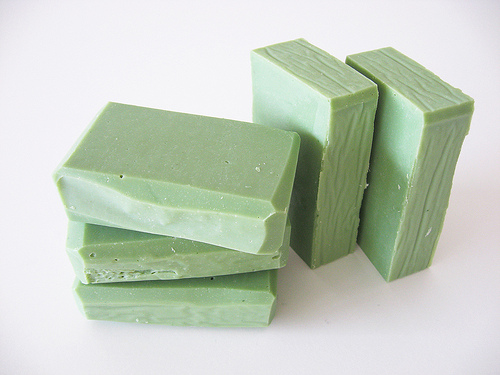- Do you use lye-based products to clear clogged drains? Do you remember references from days gone by that lye soap is scary stuff?
- This is the reason soap-makers use the term “saponification” for our natural, hand-made soaps. You can’t make soap without using lye. Most people think of lye as only a strong caustic chemical that can burn your skin, or worse. Actually, through the process of saponification and curing, the lye disappears and you’re left with a beautiful bar of soap.
- Lye is in all soaps, commericial and hand-made. “Soaps for cleansing are obtained by treating vegetable or animal oils and fats with a strongly alkaline solution. Fats and oils are composed of triglycerides; three molecules of fatty acids are attached to a single molecule of glycerol. The alkaline solution, which is often called lye, … brings about a chemical reaction known as saponification. In saponification, the fats are first hydrolyzed into free fatty acids, which then combine with the alkali to form crude soap. Glycerol (glycerine) is liberated and is either left in or washed out and recovered as a useful byproduct, depending on the process employed.” Wikipedia (Hand-made soap retains the natural glycerine, which is a skin softening ingredient removed from commercial soaps and used in other products.)
- After dissolving the lye in water, both the lye solution and the oils are separately brought to the correct temperature, then mixed until the “trace” stage. The soap is poured into moulds, kept warm and left to continue saponification for a day or two, or sometimes even three days. After this insulation period, the soap is firm enough to be removed from the mould and cut into bars. It is now safe to use, since saponification is in essence complete. However, cold-process soaps like Smallbones’ are cured and hardened on a drying rack for 2–6 weeks before being offered for sale. During this cure period, trace amounts of residual lye are consumed by saponification and excess water evaporates.
- The end result? A beautiful, long-lasting bar of natural, moisturizing and skin softening soap — with none of the nasties found in the commercial/industrial stuff. And one last note: Many soaps sold as “Castile” are not true castile soap. The real thing is made only with “saponified” olive oil, no other oils.
Source: http://www.smallbones.ca/blog/hand-made-soap-what-does-saponification-mean

